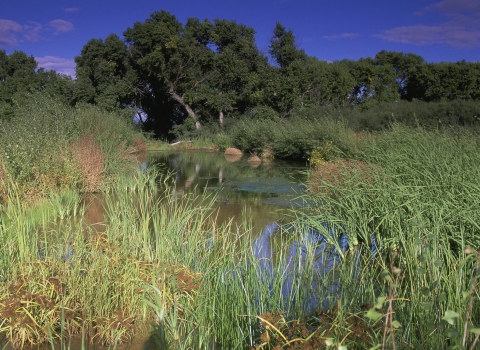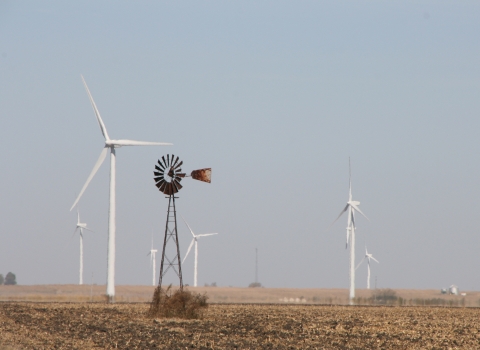A strain of naturally occurring soil bacteria tested on national wildlife refuges and other western lands may soon offer rangeland managers a safe new way to manage cheatgrass, an aggressive plant pest.
Cheatgrass is a Eurasian invasive plant that is now found in the United States, Canada, and Mexico. It covers hundreds of thousands of square miles, including the fragile sagebrush sagebrush
The western United States’ sagebrush country encompasses over 175 million acres of public and private lands. The sagebrush landscape provides many benefits to our rural economies and communities, and it serves as crucial habitat for a diversity of wildlife, including the iconic greater sage-grouse and over 350 other species.
Learn more about sagebrush steppe habitat that is the home of the increasingly rare greater sage-grouse. In the Great Basin states of Nevada, Utah, Oregon and California, cheatgrass is spreading at the rate of thousands of acres per day, endangering many more animal species and habitats. Wherever cheatgrass grows, unwanted wildfires burn hotter, more frequently and disrupt fragile ecosystems.
The native bacterium doesn’t have a catchy name; researchers refer to it simply as ACK55. But many hopes are riding on this strain of *Pseudomonas fluorescens.*
“I’m convinced it will work as long as the bacteria are applied in the fall to the soil so they can colonize emerging cheatgrass roots in the spring,” says Michael Gregg, a Land Management Research and Demonstration biologist at the Mid-Columbia River Refuges Complex in Washington state. Like a sports agent, the Fish and Wildlife Service scientist is working to convince others that ACK55 belongs in the big leagues of land management. The message is getting through.
In addition to the U.S. Fish and Wildlife Service, government agencies expressing interest in the natural cheatgrass inhibitor include the National Park Service, Bureau of Indian Affairs, Bureau of Land Management and the U.S. Forest Service.
“A biopesticide is much more cost-effective than an herbicide and less damaging to the environment and human health,” says Hilda Diaz-Soltero, senior invasive species invasive species
An invasive species is any plant or animal that has spread or been introduced into a new area where they are, or could, cause harm to the environment, economy, or human, animal, or plant health. Their unwelcome presence can destroy ecosystems and cost millions of dollars.
Learn more about invasive species coordinator for the U.S. Department of Agriculture. She hopes the inter-agency interest will speed further research designed to lead to the product’s approval as a commercial biopesticide.
Early test results have been impressive. In long-term field trials at Hanford Reach National Monument in Washington, single applications of ACK55 dramatically reduced cheatgrass in three to five years while not hurting other plants or animals. Another field trial is in progress at Deer Flat National Wildlife Refuge in Idaho. In December 2012, the Fish and Wildlife Service committed $200,000 to scale up ACK55 tests to meet Environmental Protection Agency biopesticide registration requirements.
ACK55 is not the only new cheatgrass management tool being studied. “There is a fungus, colorfully named Black Fingers of Death, that is being tested by other researchers,” says Fred Wetzel, National Wildland Fire and Emergency Response advisor and ACK55’s project leader for the Fish and Wildlife Service. In contrast to other controls, Wetzel likens ACK55 to using laser surgery to target and suppress the plant’s developing root cells. “This cheats the plant out of everything it needs to grow and reproduce,” he says.
Many land managers recognize that control of this invasive grass will require more than one management method.
The scientist who discovered ACK55 and devised a method to apply it is Ann C. Kennedy, a soil microbiologist with the USDA’s Agricultural Research Service. Kennedy stresses ACK55’s safety. She says the native soil bacteria inhibit just three grass species: cheatgrass, medusa head and jointed goat grass. All are invasive species of the sage steppe habitat. Wheat, native bunch grasses and broadleaf plants are unaffected. Another advantage of ACK55 is that applied bacteria don’t survive in the soil indefinitely; after three to five years, soil bacteria numbers return to pre-treatment levels.
By applying ACK55 in the fall, scientists aim to give the cold-loving native bacteria time to colonize the soil before the spring growing season. “One of the issues with cheatgrass is it greens up early in spring, so it gets a head start on other plants and outcompetes them,” says Gregg. “What we’re trying to do is remove that competitive edge so native plants can survive.”
Working with the EPA, the Fish and Wildlife Service and a team of resource scientists are moving toward federal registration of ACK55 as a biopesticide. Only then can a patented treatment be licensed for commercial sale and distribution. Diaz-Soltero sees licensing as five or more years off. “The registration process is long and it’s science,” she says. “We have to do the work systematically and thoroughly, dealing with challenges and questions as they arise.”
Biologists and land managers are anxious to keep this process moving.
“We don’t have time to waste.” says Wetzel.
###
The National Wildlife Refuge System protects wildlife and wildlife habitat on more than 150 million acres of land and water from the Caribbean to the Pacific, Maine to Alaska. Refuges also improve human health, provide outdoor recreation and support local economies. Visit our home pageat www.fws.gov/refuges. Follow us on Facebookand Twitter.

